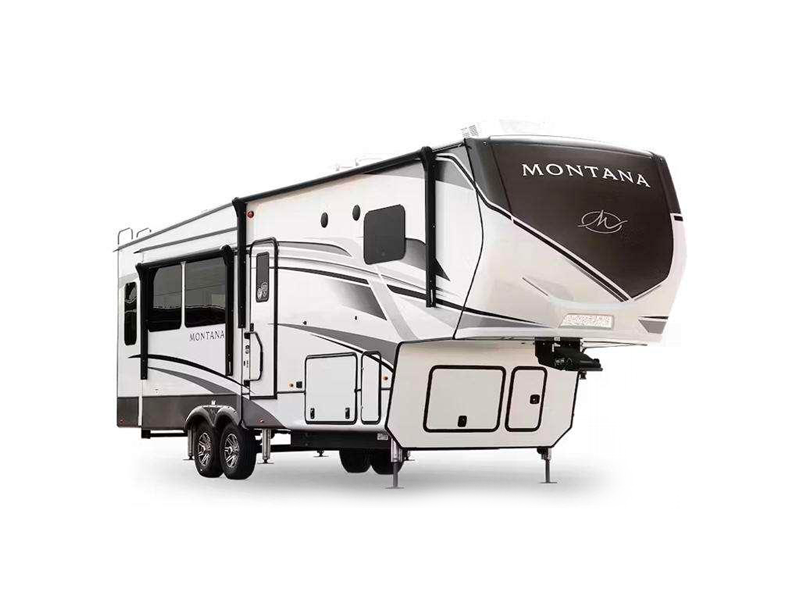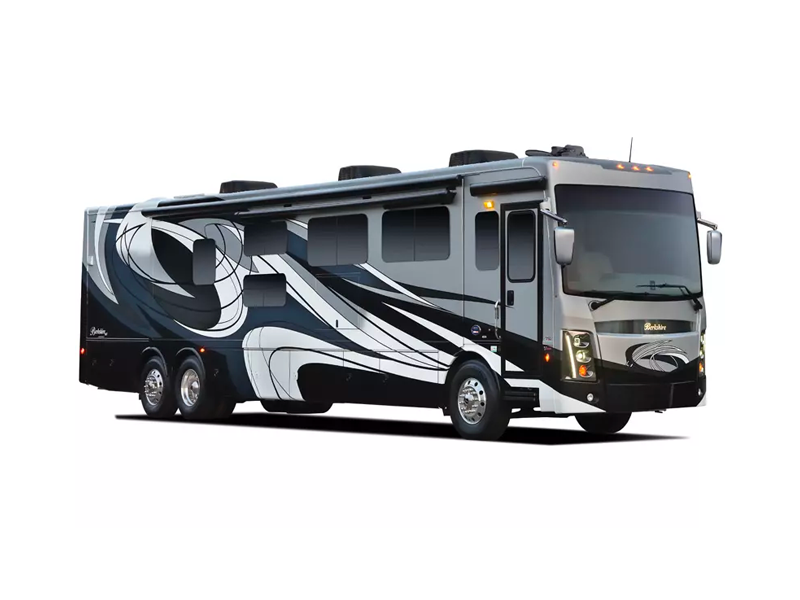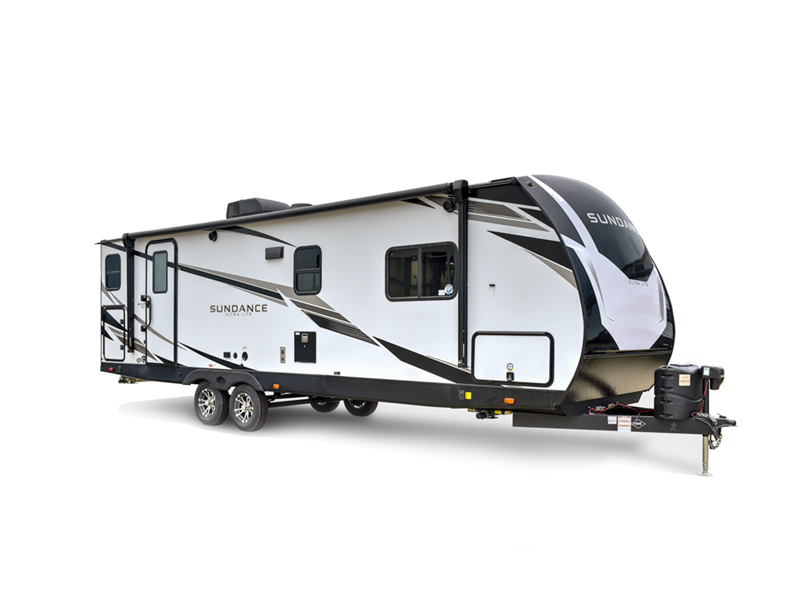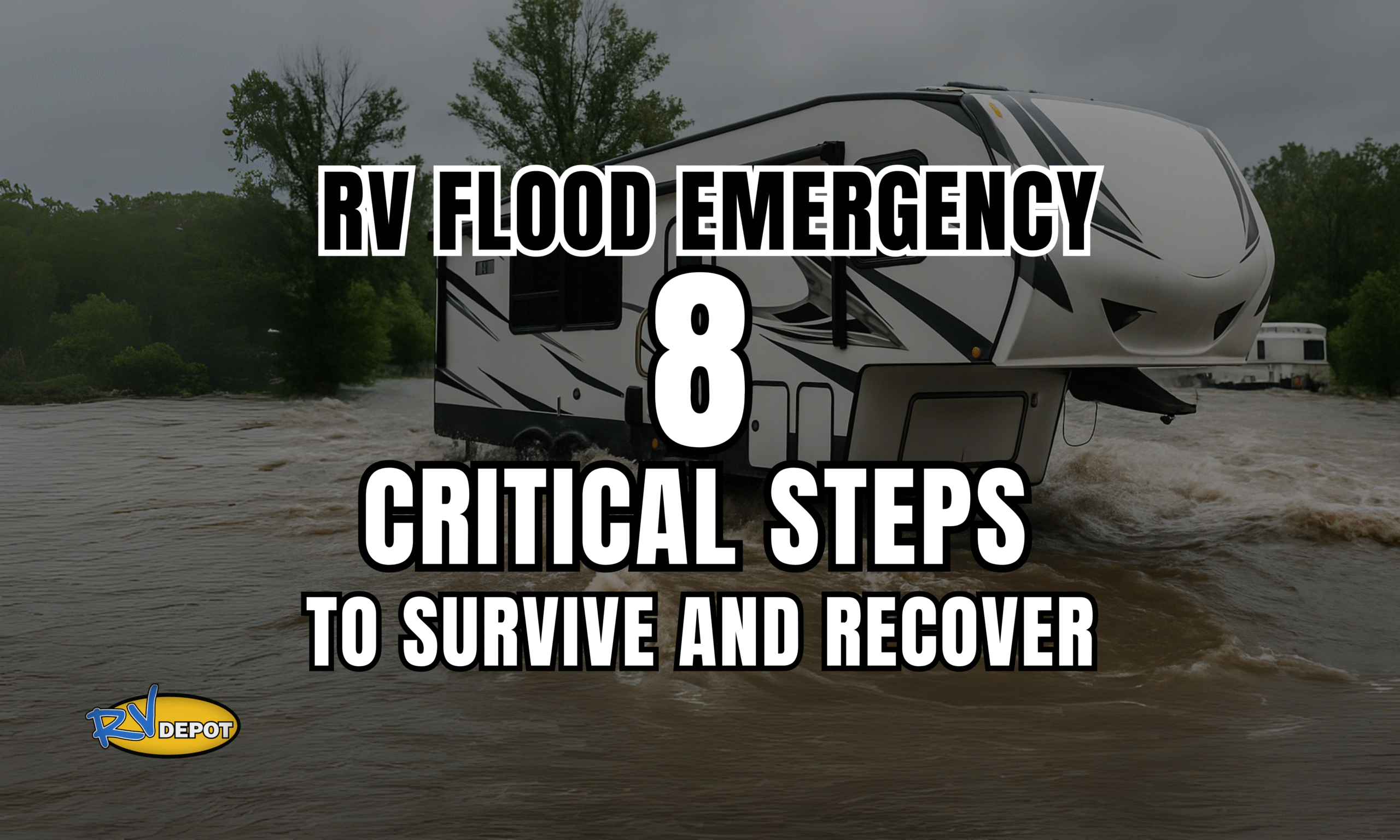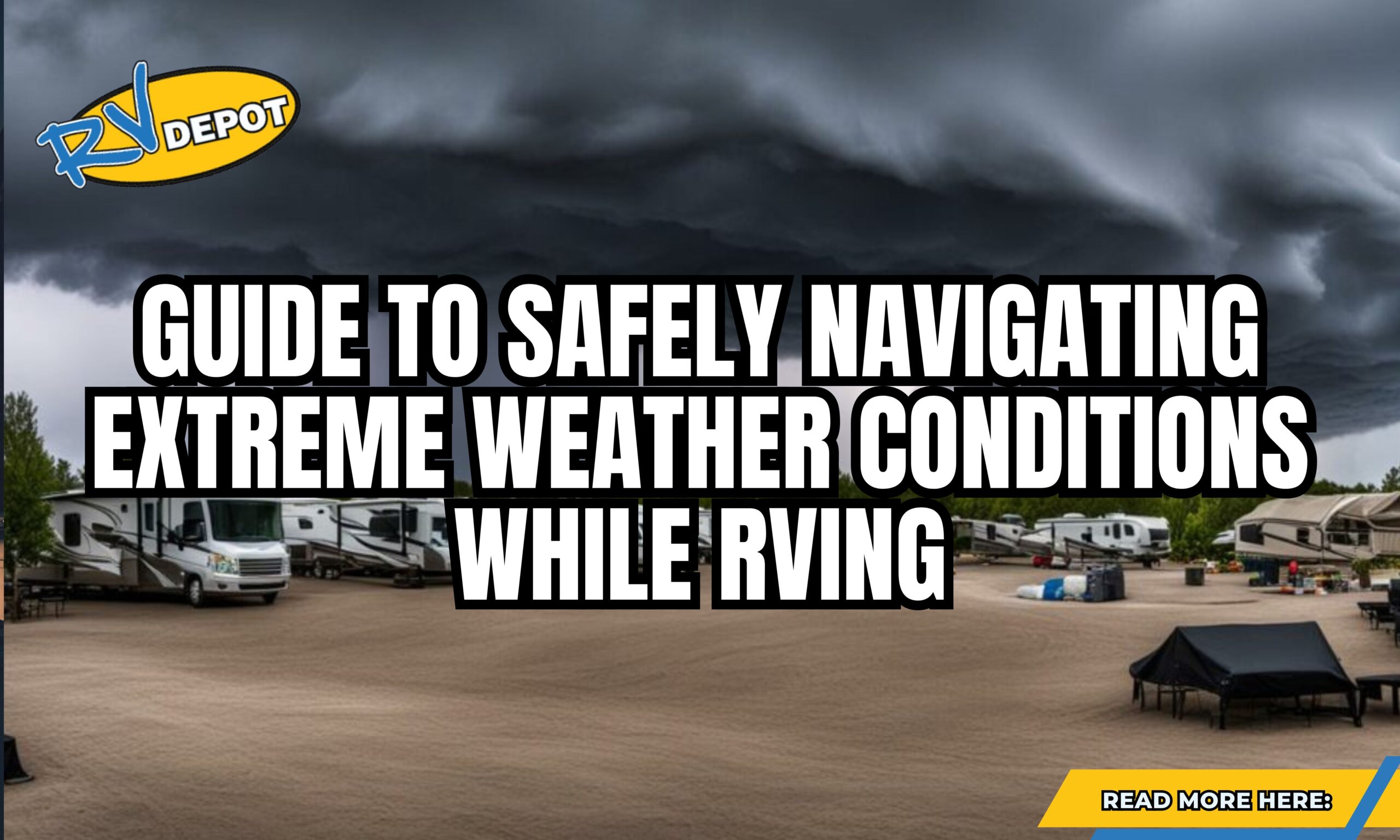The weather alert comes through your phone at 3 AM: “Flash Flood Warning – Seek Higher Ground Immediately.” Your RV is parked in what seemed like a safe campground, but now you’re facing one of the most dangerous situations any RVer can encounter. An RV flood emergency requires immediate, decisive action to protect both your life and your investment, but many RVers have never prepared for this scenario.
RV flood emergencies claim more lives annually than hurricanes, tornadoes, and lightning combined, and RVs face unique vulnerabilities during these events. Unlike permanent structures, RVs can be swept away by surprisingly shallow water—just 12 inches of moving water can float a travel trailer, while 24 inches can move most motorhomes. Understanding proper RV flood emergency procedures can mean the difference between a frightening experience and a life-threatening disaster.
Critical RV Flood Statistics:
- RVs can float in as little as 12 inches of moving water
- 6 inches of moving water can knock adults off their feet
- More people drown in vehicles during floods than in any other location
- 75% of flood-related deaths occur in vehicles attempting to drive through water
An RV flood emergency tests your preparedness, decision-making, and recovery skills all within a compressed timeframe. Those who understand proper RV flood procedures and have prepared in advance fare much better than those caught completely off guard. Whether you’re facing your first RV flood threat or want to improve your emergency preparedness, this guide provides the essential knowledge you need to protect yourself and your RV investment.
Immediate Emergency Response: Life Safety First
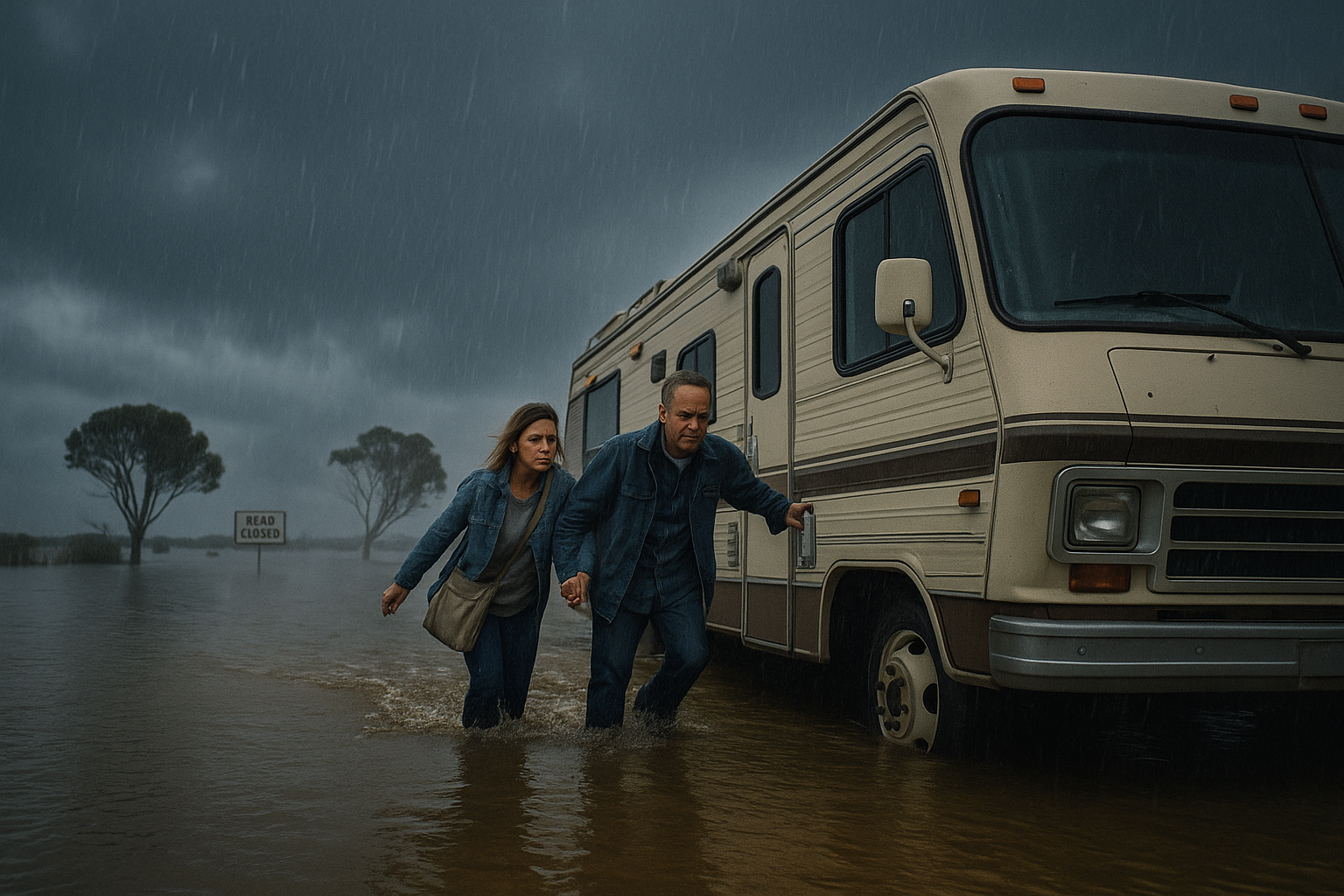
Emergency Equipment and Supplies
Essential Emergency Kit for RV Flood Situations:
| Item Category | Specific Items | Quantity | Storage Location |
|---|---|---|---|
| Communication | Waterproof cell phone case, weather radio | 2 devices | Upper cabinets |
| Safety | Life jackets, emergency whistle | 1 per person + 2 extra | Accessible compartment |
| Tools | Knife, multi-tool, rope | 1 each | Emergency bag |
| Supplies | Water, non-perishable food | 3 days per person | Sealed containers |
| Medical | First aid kit, medications | Complete kit | Waterproof container |
Power and Utilities Shutdown: If you have time and can do so safely during an RV flood emergency, disconnect electrical hookups and shut off propane systems. Water and electricity create deadly combinations, while propane leaks can cause explosions. However, never attempt these actions if flood water is rising rapidly or if doing so puts you in danger.
Documentation and Valuables: Quickly gather essential documents (insurance papers, identification, vehicle titles) and irreplaceable items if possible during an RV flood emergency, but only if evacuation time permits. Pre-planning by keeping these items in a waterproof, grab-and-go container makes this process much faster and more effective.
Understanding Flood Risks and RV Vulnerabilities
How Floods Affect RVs Differently
RVs face unique challenges during RV flood events that make them more vulnerable than traditional structures or even standard vehicles. Understanding these RV flood vulnerabilities helps you make better decisions during emergencies and prepare more effectively for potential threats.
RV-Specific Flood Vulnerabilities:
Buoyancy and Stability Issues: RVs are essentially hollow boxes with relatively light construction compared to their size. This design makes them susceptible to floating in much less water than their size might suggest during an RV flood emergency. Travel trailers can begin floating in 12 inches of water, while large motorhomes may float in 18-24 inches.
Electrical System Vulnerabilities: RV electrical systems are typically mounted lower than those in houses, making them more susceptible to water damage during RV flood conditions. Shore power connections, converters, and distribution panels often suffer damage even in relatively minor RV flood events.
Structural Integrity Concerns: Water pressure against RV walls and floors can cause structural damage, especially if debris impacts the RV during flooding. Seams and joints that normally handle wind and road stress may fail under water pressure and debris impact.
Flood Types and RV Response Strategies
Flash Floods: Develop rapidly with little warning, often in areas that don’t typically flood. RVs in arroyos, dry creek beds, or low-lying areas face extreme danger during these sudden RV flood emergencies. Response time may be measured in minutes, making preparation and quick decision-making critical.
River Flooding: Usually develops more slowly, providing more warning time but potentially lasting much longer. RVs near rivers or in flood plains may have time for organized evacuation but could face extended displacement during prolonged RV flood conditions.
Storm Surge (Coastal Areas): Salt water flooding presents additional challenges due to corrosive effects on RV systems and components. Coastal RV travel requires enhanced preparation and faster evacuation decisions during RV flood emergencies.
Urban Flooding: Overwhelmed drainage systems can create dangerous conditions even in developed campgrounds. Storm water runoff can carry contamination and debris that creates additional health and safety hazards during RV flood situations.
Post-Flood Damage Assessment and Safety
Initial Safety Assessment
Before re-entering your RV after flood waters recede, conduct a thorough safety assessment from outside the vehicle. Flood-damaged RVs can present multiple hazards including electrical dangers, structural instability, and contamination risks.
External Safety Inspection Checklist:
Structural Assessment:
- Check for tilting, shifting, or obvious structural damage
- Examine the undercarriage for debris accumulation or damage
- Inspect wheels and axles for debris or damage
- Look for separation at seams or joints
Electrical Safety:
- Ensure all shore power is disconnected before inspection
- Check for exposed wiring or damaged electrical components
- Look for evidence of water entry in electrical compartments
- Never enter if you suspect electrical hazards
Contamination Indicators:
- Notice sewage smells or obvious contamination
- Check for hazardous debris or chemical containers
- Look for oil or fuel spills around the RV
- Assess water discoloration or unusual odors
Professional vs. DIY Assessment
When to Call Professionals Immediately:
| Damage Type | Professional Required | Reason |
|---|---|---|
| Structural damage | Always | Safety and insurance |
| Electrical system flooding | Recommended | Shock and fire risk |
| Sewage contamination | Always | Health hazards |
| Propane system damage | Always | Explosion risk |
| Frame or axle damage | Always | Structural integrity |
DIY Assessment Capabilities: Minor water intrusion, surface cleaning, and basic drying efforts can often be handled by RV owners with proper safety precautions and equipment. However, err on the side of caution and consult professionals for any safety-related concerns.
Comprehensive Recovery and Restoration Process
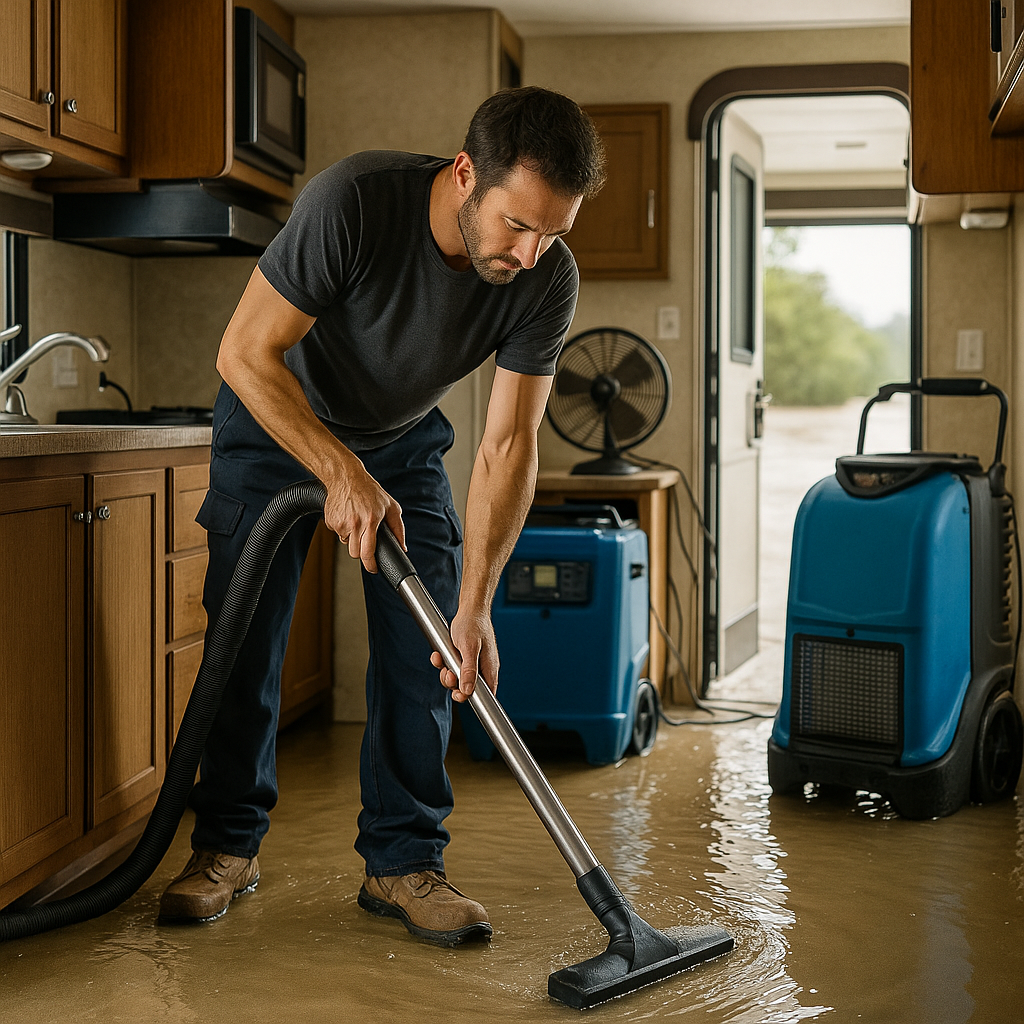
Water Removal and Drying Procedures
Immediate Water Extraction: Time is critical in preventing secondary damage from mold and mildew. Begin water removal as soon as it’s safe to enter the RV, starting with standing water and progressing to absorbed moisture in materials and furnishings.
Water Removal Priority Steps:
| Step | Action | Tools Needed | Time Frame |
|---|---|---|---|
| 1 | Remove standing water | Wet/dry vacuum, pumps | First 2 hours |
| 2 | Extract saturated carpets | Carpet extractors | 2-6 hours |
| 3 | Remove wet furnishings | Hand tools, dollies | 6-12 hours |
| 4 | Access hidden water | Inspection cameras, moisture meters | 12-24 hours |
Ventilation and Air Movement: Proper air circulation is essential for thorough drying and mold prevention. Open all windows, doors, and vents to create cross-ventilation. Use fans strategically to move air through the RV and focus on areas with limited natural airflow.
Dehumidification Strategy: Commercial dehumidifiers can remove thousands of gallons of moisture from the air and materials. Size dehumidifiers appropriately for RV spaces and empty collection tanks frequently. Monitor humidity levels with hygrometers, aiming for 30-50% relative humidity.
Content and Material Removal
Salvageable vs. Disposable Items:
| Item Category | Usually Salvageable | Usually Discard | Special Considerations |
|---|---|---|---|
| Electronics | Undamaged items | Water-exposed items | Professional cleaning possible |
| Furniture | Solid wood, metal | Particle board, upholstered | Depends on water type |
| Textiles | Washable fabrics | Absorbent materials | Professional cleaning for valuable items |
| Documents | Wet but intact | Severely damaged | Freeze-drying possible for important items |
Health and Safety Priorities: Remove any items that could promote mold growth, retain contamination, or pose health risks. This includes carpeting, mattresses, pillows, and any porous materials that absorbed flood water. When in doubt, dispose of questionable items rather than risk health problems.
Cleaning and Disinfection Protocols: All surfaces that contacted flood water require thorough cleaning and disinfection. Use appropriate cleaning agents for different materials and surfaces, paying special attention to areas that will be difficult to access later during reconstruction.
Systems Inspection and Restoration
Electrical System Recovery: Flood-damaged electrical systems require professional inspection before restoration of power. Water damage to wiring, outlets, and electrical panels can create ongoing fire and shock hazards even after apparent drying.
Electrical Restoration Process:
- Professional inspection and testing of all circuits
- Replacement of contaminated wiring and components
- Cleaning and treatment of electrical panels and distribution points
- Testing and certification before power restoration
Plumbing System Assessment: Check water lines, pumps, and holding tanks for damage and contamination. Flood water can introduce contaminants into fresh water systems that require thorough sanitization before use.
HVAC System Evaluation: Heating and air conditioning systems that were submerged or exposed to flood water may require complete replacement. Ductwork, filters, and mechanical components can harbor mold and contamination that’s difficult to eliminate completely.
Insurance Claims and Financial Recovery
Documentation and Claims Process
Essential Documentation for Insurance Claims:
Photographic Evidence:
- Before cleanup begins, photograph all damage extensively
- Include wide shots showing overall conditions and close-ups of specific damage
- Document water levels with measuring tools for reference
- Photograph damaged items before disposal
Written Documentation:
- Detailed inventory of damaged items with estimated values
- Timeline of events and response actions taken
- Professional inspection reports and repair estimates
- Receipts for emergency expenses and temporary lodging
Insurance Claim Strategy:
| Documentation Type | Purpose | Timing |
|---|---|---|
| Immediate photos | Establish damage extent | Within first 24 hours |
| Professional inspection | Determine repair costs | Within first week |
| Detailed inventory | Support content claims | Ongoing during cleanup |
| Repair estimates | Establish claim value | Before repairs begin |
Financial Planning for Recovery
Expected Recovery Costs: Flood damage restoration can range from a few thousand dollars for minor water intrusion to complete RV replacement for severe damage. Understanding potential costs helps with insurance negotiations and financial planning.
Recovery Cost Categories:
| Damage Level | Typical Costs | Timeline | Insurance Coverage |
|---|---|---|---|
| Minor water damage | $2,000-$8,000 | 2-4 weeks | Usually covered |
| Moderate flooding | $8,000-$25,000 | 1-3 months | Depends on policy |
| Severe damage | $25,000+ or total loss | 3+ months | May exceed RV value |
Alternative Accommodation Costs: Factor in temporary lodging expenses while your RV is being repaired. Many insurance policies include coverage for additional living expenses, but understanding limits and requirements helps avoid out-of-pocket costs.
Prevention and Preparedness Strategies
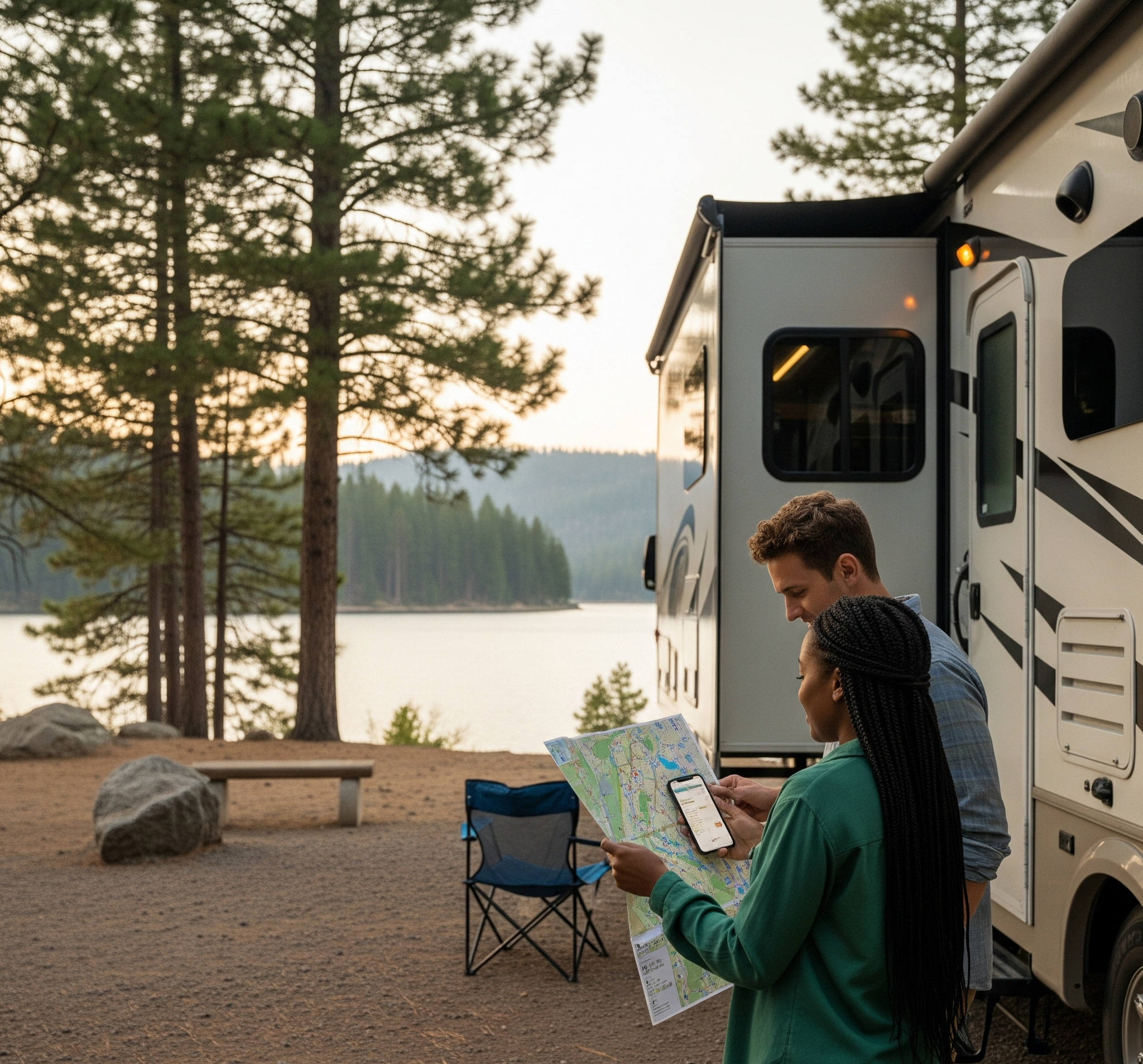
Pre-Trip Planning and Risk Assessment
Weather Monitoring Systems: Invest in reliable weather monitoring equipment and services that provide advanced warning of potential flood conditions. Modern weather apps and NOAA weather radio systems can provide critical early warning that enables proactive response.
Campground Selection Criteria: Research campground locations and elevation relative to local water sources. Avoid known flood-prone areas during high-risk seasons, and always have evacuation routes planned before settling in any location.
Seasonal Risk Awareness:
| Season | Primary Flood Risks | Prevention Strategies |
|---|---|---|
| Spring | Snowmelt, heavy rainfall | Monitor snowpack, avoid low areas |
| Summer | Flash floods, hurricanes | Watch severe weather, coastal awareness |
| Fall | Hurricane season, heavy rainfall | Track storm systems, early evacuation |
| Winter | Ice dams, sudden thaws | Monitor temperature changes |
Emergency Preparedness Equipment
Early Warning Systems: Weather radios with emergency alerts, smartphone apps with location-based warnings, and communication with local emergency management agencies provide the advance notice needed for effective response.
Evacuation Planning: Pre-planned evacuation routes, emergency meeting points, and alternative accommodation arrangements enable quick response when conditions deteriorate rapidly. Practice evacuation procedures so they become automatic during high-stress situations.
Emergency Supply Management: Maintain emergency supplies that are easily accessible and transportable during evacuations. Rotate supplies regularly and ensure all family members know location and contents of emergency kits.
RV Depot’s Flood Recovery Support Services
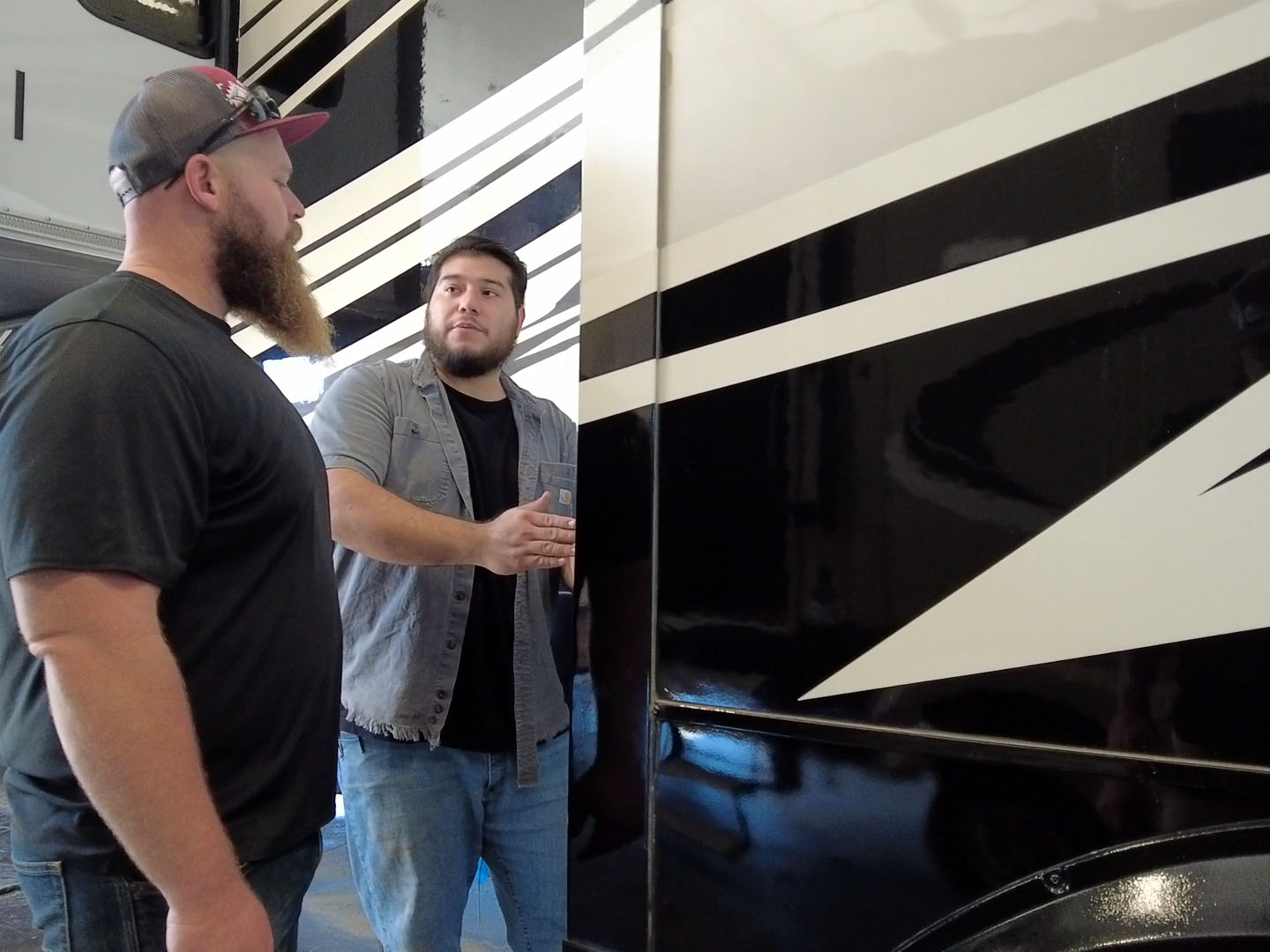
Damage Assessment and Repair Coordination
At RV Depot, we understand that flood damage recovery involves much more than simple repairs. Our experienced technicians can provide comprehensive damage assessments that help you understand the full scope of necessary repairs while working with insurance companies to ensure appropriate coverage.
Our certified inspection services include structural assessment, electrical system evaluation, and contamination testing that provides the documentation needed for insurance claims and repair planning. We work with customers to prioritize repairs and develop realistic timelines for returning RVs to service.
Professional Repair Services:
- Complete electrical system replacement and upgrading
- Structural repairs and reinforcement
- Interior restoration and replacement
- System integration and testing
Insurance Claim Support
We provide detailed repair estimates and damage documentation that support insurance claims while ensuring all necessary repairs are included in settlement negotiations. Our experience with insurance adjusters helps customers navigate the claims process more effectively.
For RVs with extensive flood damage, replacement may be more cost-effective than repair. We help customers evaluate options while maximizing insurance settlements and trade-in values for damaged units.
Replacement Assistance:
- Insurance settlement optimization strategies
- New RV selection based on improved flood resistance
- Trade-in evaluation for damaged units
- Financing options for replacement purchases
Your RV Flood Emergency Action Plan
An RV flood emergency tests every aspect of your preparedness and decision-making abilities under extreme stress. The difference between a manageable crisis and a life-threatening disaster often comes down to advance preparation, quick recognition of danger, and decisive action when conditions deteriorate during RV flood situations.
Understanding proper RV flood emergency procedures, having the right equipment readily available, and knowing when to evacuate versus when to shelter can protect both your life and your RV investment. More importantly, this knowledge provides confidence that enables better decision-making during high-stress RV flood emergency situations.
Remember, no RV or possession is worth risking your life. When facing RV flood conditions, always prioritize personal safety over property protection. With proper preparation and knowledge, you can minimize both safety risks and property damage when RV flood emergencies arise.

